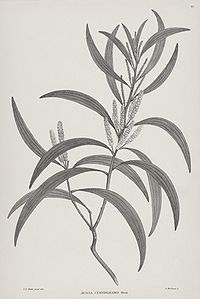
Acacia leiocalyx
Encyclopedia

Queensland
Queensland is a state of Australia, occupying the north-eastern section of the mainland continent. It is bordered by the Northern Territory, South Australia and New South Wales to the west, south-west and south respectively. To the east, Queensland is bordered by the Coral Sea and Pacific Ocean...
, Australia and as far south as Sydney
Sydney
Sydney is the most populous city in Australia and the state capital of New South Wales. Sydney is located on Australia's south-east coast of the Tasman Sea. As of June 2010, the greater metropolitan area had an approximate population of 4.6 million people...
in N.S.W. It is widespread and common in eucalypt
Eucalypt
Eucalypts are woody plants belonging to three closely related genera:Eucalyptus, Corymbia and Angophora.In 1995 new evidence, largely genetic, indicated that some prominent Eucalyptus species were actually more closely related to Angophora than to the other eucalypts; they were split off into the...
woodlands, especially on well-drained, shallow soils. It is short-lived and grows 6-7 metres (20-23 ft.) tall, with a trunk about 180 mm (7 inches) in diameter.
Description
A small AcaciaAcacia
Acacia is a genus of shrubs and trees belonging to the subfamily Mimosoideae of the family Fabaceae, first described in Africa by the Swedish botanist Carl Linnaeus in 1773. Many non-Australian species tend to be thorny, whereas the majority of Australian acacias are not...
tree with furrowed bark; sickle-shaped green leaves with prominent veins, the bottom two joined near the base. Flowers yellow, in narrow spikes. Narrow, rather curly pods in loose bunches. It usually flowers June to October.
Taxonomy
There were several closely related trees which used to all come under the name of Acacia cunninghamii, but have been now identified as a number of separate species. The Acacia cunninghamii 'group' all have spiky inflourescences and large phyllodes. They are closely interrelated and taxonomically 'difficult' species, and are often confused and poorly defined.A. leiocalyx is most closely related to Acacia concurrens
Acacia concurrens
Acacia concurrens, commonly known as Curracabah or black wattle, is a shrub native to Queensland in eastern Australia....
, but the differences between the two species are subtle. In A. leiocalyx the small branches are smooth, sharply angular and usually red-brown, the pulvinus
Pulvinus
A pulvinus is a joint-like thickening at the base of a plant leaf or leaflet that facilitates growth-independent movement. It consists of a core of vascular tissue within a flexible, bulky cylinder of thin-walled parenchyma cells...
is short and red, and the calyx is hairless, or almost so. A. concurrens, on the other hand, has stouter, angular branchlets which are scaly and usually not distinctly reddish, a long grey-green pulvinus, and calyces with a few stiff short hairs towards their base. Some intermediates or hybrids between the two species occur in northern N.S.W. It is also related to Acacia crassa. Two subspecies are recognized: Acacia leiocalyx (Domin) Pedley subsp. leiocalyx and Acacia leiocalyx subsp. herveyensis" Pedley, Austrobaileya 1: 180 (1978)
Distribution
"The species includes many different forms which are widespread in QueenslandQueensland
Queensland is a state of Australia, occupying the north-eastern section of the mainland continent. It is bordered by the Northern Territory, South Australia and New South Wales to the west, south-west and south respectively. To the east, Queensland is bordered by the Coral Sea and Pacific Ocean...
from the coast to more than 325 km inland, mostly on stony or gravelly soils. It is eaten in times of scarcity but is not of major importance as a drought fodder (Everist, 1969)."

